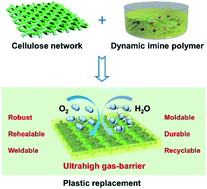Robust, high-barrier, and fully recyclable cellulose-based plastic replacement enabled by a dynamic imine polymer†
Abstract
The development of novel sustainable materials as plastic replacements has become an urgent task, because the increasing accumulation of nondegradable fossil-based plastic wastes on land and in oceans has led to serious long-term threats to the ecosystem. Herein, a novel type of cellulose-based sustainable material, paper–polyimine composites (PPCs), were developed via the functionalization of cellulose papers using polyimine covalent adaptable networks (CANs). The polyimine infiltrates into the porous structure of cellulose papers and non-covalently bonds to cellulose fiber networks via hydrogen bonding, forming interpenetrating networks. The tensile strength and Young's modulus of PPCs can reach 71 MPa and 3.2 GPa, which are significantly higher than those of most commercially available plastics. The PPCs exhibit good malleability, re-healability, weldability, and moldability. The closed-loop recycling of the polymer matrix and cellulose papers has also been demonstrated. The recycled materials can be 100% reused in the production of next generation composites. More importantly, such PPCs exhibit excellent waterproof performance, superhigh gas (oxygen and moisture) barrier capability, and excellent solvent resistance. Therefore, PPCs represent a novel class of highly green and sustainable materials that can be used as plastic replacements.



 Please wait while we load your content...
Please wait while we load your content...